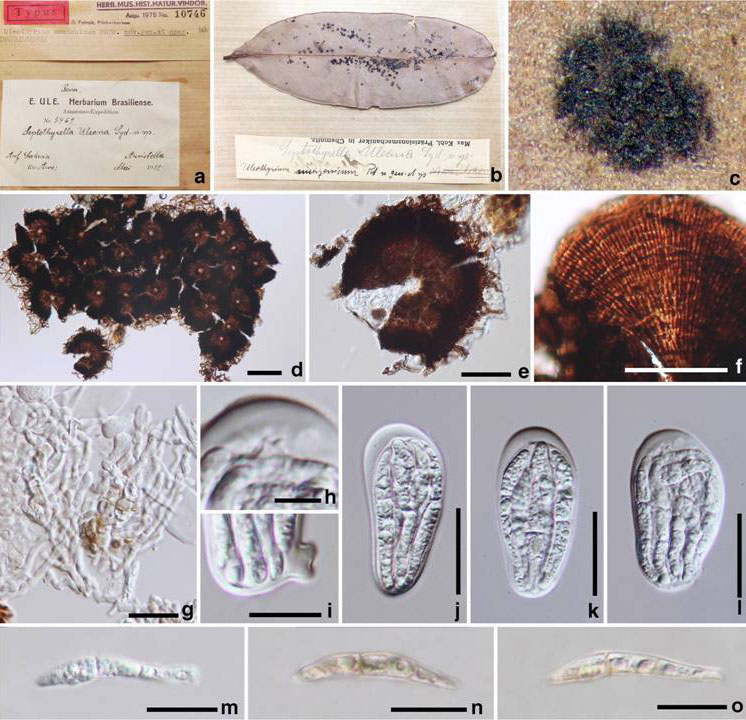Uleothyrium amazonicum Petr., Annls mycol. 27(5/6): 388 (1929) Fig. 32
≡ Septothyrella uleana Syd. & P. Syd., Annls mycol. 14(1/2): 96 (1916)
Type: W 10746.
Epiphytes on leaves. Superficial hyphae composed of densely branched, septate, brown hypha, 3–4μm thick, lacking appressoria. Sexual state: Thyriothecia 40–70μm, gregarious, usually clustered, circular, elongate to ellipsoidal, black or brown, surrounded by brown to black hyphae, opening by a central pore. Upper wall comprising a thin layer of mostly neatly arranged brown cells, which are branched at the outer rim, from which hyphae strands develop, base poorly developed. Asci 30–38×15–18μm (x = 32.7×16.2μm, n=10), 8- spored, bitunicate, clavate to ellipsoidal, apedicellate, apical region of asci usually with a thick opaque region. Ascospores 28–32×3–5μm (x = 30.5×4.2μm, n=10), parallel in the asci, straight or slightly curved, elongate fusoid, hyaline, two-celled, constricted at the septum. Asexual state: “Septothyrella”, coelomycetous, Pycnidia 85–150 μm, dimidiate to scutate, densely aggretated, rounded, crusty, with a 10–15μm wide pore. Conidiogenous cells cylindrical, flaskshaped, hyaline with brown walls, smooth to lightly verruculose, one-celled, holoblastic. Conidia 18–25×3– 4μm, hyaline, cylindrical to clavate, 1–3-septate, not constricted at the septa (asexual state description from Sivanesan 1984).
Material examined: BRAZIL, Rio Aire, Auritella, on leaves of Salacia sp. (Celastraceae), May 1911, Ule Herbarium Brasiliense 3469 (W 10746, holotype).
Fig. 1 Uleothyrium amazonicum (holotype). a, b Specimens and description. c Ascomata on substrate. d, e Ascomata viewed on squash mount. f Upper walled viewed in squash mount. g Hamatheciu. h Ocular chamber. i Pedicellate. j–l Asci. m Ascospore when immature. n–o Ascospore at maturity. Scale bar: d=100μm, e, f=50μm, j–l=20μm. g, i, m–o=10μm, h=5μm

